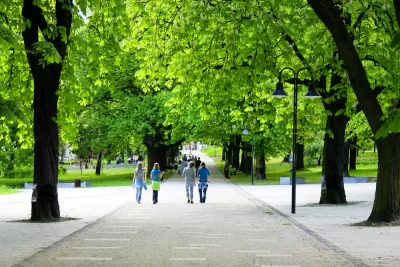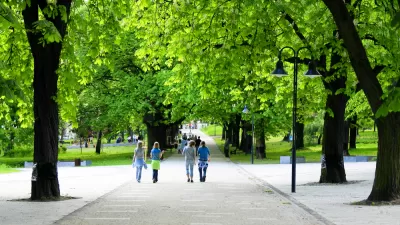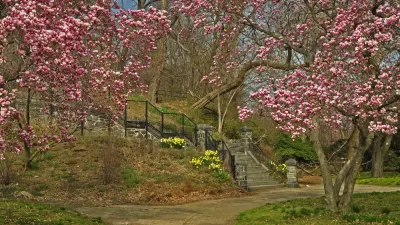This report estimates that U.S. cities could save half a trillion dollars by investing in "smart surface technologies." The study takes into account obvious factors like energy use and less intuitive ones like tourism revenues.

A new report says cities could save big by adopting green design features like urban tree cover, green roofs, and reflective pavements. The study, Rachel Dovey writes, "comes from clean energy advisory and venture capital firm Capital E, with funding from the JPB Foundation (and a host of national partners)."
"By crunching numbers in three cities, Washington D.C., Philadelphia and El Paso, authors Greg Kats and Keith Glassbrook conclude that investing in what they term 'smart surface technologies' could deliver roughly half a trillion dollars in net financial benefits nationally."
Examples include an expanded urban forest in D.C. to provide energy-saving "ambient cooling," as well as less obvious benefits like the preservation of Philadelphia's tourism sector as temperatures rise.
"But many of the benefits [the report] analyzed," Dovey notes, "exemplify the kinds of long-term, systemic cost-savers that fiscal year-conscious governments often shy away from." Still, half a trillion is a eye-catching figure, especially considering the fact that many of these improvements are relatively cheap to implement.
FULL STORY: Here’s How Much Money Green Design Could Save Cities

Study: Maui’s Plan to Convert Vacation Rentals to Long-Term Housing Could Cause Nearly $1 Billion Economic Loss
The plan would reduce visitor accommodation by 25,% resulting in 1,900 jobs lost.

North Texas Transit Leaders Tout Benefits of TOD for Growing Region
At a summit focused on transit-oriented development, policymakers discussed how North Texas’ expanded light rail system can serve as a tool for economic growth.

Why Should We Subsidize Public Transportation?
Many public transit agencies face financial stress due to rising costs, declining fare revenue, and declining subsidies. Transit advocates must provide a strong business case for increasing public transit funding.

How to Make US Trains Faster
Changes to boarding platforms and a switch to electric trains could improve U.S. passenger rail service without the added cost of high-speed rail.

Columbia’s Revitalized ‘Loop’ Is a Hub for Local Entrepreneurs
A focus on small businesses is helping a commercial corridor in Columbia, Missouri thrive.

Invasive Insect Threatens Minnesota’s Ash Forests
The Emerald Ash Borer is a rapidly spreading invasive pest threatening Minnesota’s ash trees, and homeowners are encouraged to plant diverse replacement species, avoid moving ash firewood, and monitor for signs of infestation.
Urban Design for Planners 1: Software Tools
This six-course series explores essential urban design concepts using open source software and equips planners with the tools they need to participate fully in the urban design process.
Planning for Universal Design
Learn the tools for implementing Universal Design in planning regulations.
City of Santa Clarita
Ascent Environmental
Institute for Housing and Urban Development Studies (IHS)
City of Grandview
Harvard GSD Executive Education
Toledo-Lucas County Plan Commissions
Salt Lake City
NYU Wagner Graduate School of Public Service





























